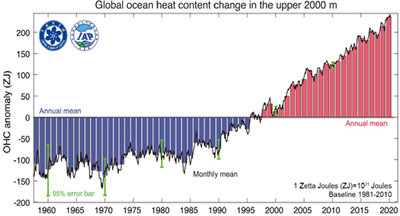Upper Ocean Temperatures Hit Record High in 2020

Figure: Global upper 2000 m OHC estimates from 1958 through 2020 from IAP. The histogram presents annual anomalies relative to a 1981−2010 baseline, with positive anomalies shown as red bars and negative anomalies as blue.
© NOAA/NCEI
CISESS Scientists Alexey Mishonov and Jim Reagan are coauthors on a new article published online on January 13th in Advances in Atmospheric Science. To calculate ocean temperature and salinity anomalies in the upper 2000 m layer, using all available observations from various measurement devices held in the World Ocean Database of NOAA/NCEI. Observations from 1958 to 2020 were used, along with data provided by the Institute of Atmospheric Physics of the Chinese Academy of Sciences.Mishonov and Reagan work on the World Ocean Database at NCEI. The most recent data indicates that the Ocean Heat Content (OHC) in the upper 2000 m layer of the world’s oceans has increased with a mean rate of 5.7 ± 1.0 ZJ yr−1 for the 1958−2020 period (see figure).
There is a more rapid increase in OHC that began in the ~1980s and has continued unabated since then. From 1986 to 2020, the trend in OHC is 9.1 ± 0.3 ZJ yr−1, almost eight times larger than the trend from 1958 to 1985 (1.2 ± 0.6 ZJ yr−1), while the estimates of uncertainty have decreased as instruments and sampling improved. The OHC value for 2020 is higher than the value for 2019, by 20 ± 8.3 ZJ using the IAP estimate, and by 1 ± 3.5 ZJ using the NCEI estimate. Both are the highest on record. This publication was coordinated with the NCEI State of the Climate Report for 2020, which was released on January 14 and cites this article.
Cheng, Lijing, John Abraham, Kevin E. Trenberth, John Fasullo, Tim Boyer, Ricardo Locarnini, Bin Zhang, Fujiang Yu, Liying Wan, Xingrong Chen, Xiangzhou Song, Yulong Liu, Michael E. Mann, Franco Reseghetti, Simona Simoncelli, Viktor Gouretski, Gengxin Chen, Alexey Mishonov, James Reagan and Jiang Zhu, 2021: Upper ocean temperatures hit record high in 2020. Adv. Atmos. Sci., in press, https://doi.org/10.1007/s00376-021-0447-x.
« Back